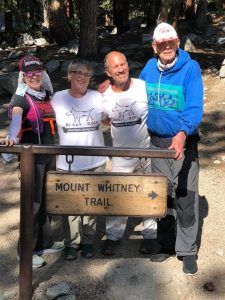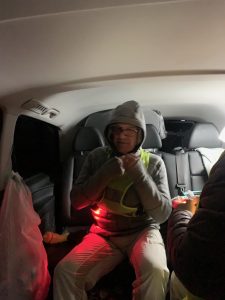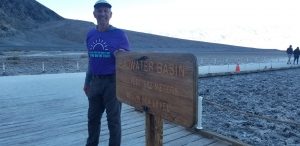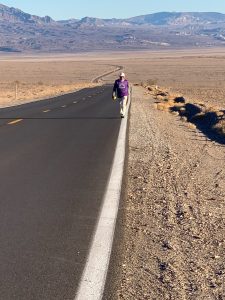Winter Badwater, Start to Father Crowley
“What do you think about when . . .” you cover 146 miles across the desert, and up the tallest mountain in the continental United States? Or when you run across America, or complete the Leadville Trail 100 mile run, or complete the Pikes Peak marathon four consecutive times?
“What do you think about?” is one of the most common questions I’m asked. Yet, it’s one thing that most ultrarunners don’t seem to talk, or write, about. Stories are about the physically grueling tasks. How much they “suffered” – the blisters, vomiting, muscle cramps, getting lost, or sleep monsters. Yet for me, ultrarunning has always been a creative process. A way to connect with nature and my surroundings, and the history and culture of the places I pass through. A chance to remember people in my life, including those who have passed. A time to process events in my life; yes, a sort of therapy. So, in this series please allow me some latitude to share ethereal, frou-frou ideas and thoughts.

This video capture of me from the DVNP circumnav in 2012, above Panamint Valley, could have been the very last image of me. Ever.
Since you’re here on my blog, you probably know that I’ve been fortunate enough to complete a few athletic adventures in, around, and across Death Valley. With a friend, I survived a summer self-supported, 400 plus mile circumnavigation of Death Valley National Park. I’ve completed the Badwater ultramarathon 20 times, always going the complete 146 miles to the summit of Whitney. I did a solo, self-contained crossing, as well as the first ever quad crossing. In August 2020, I completed my 30th crossing of Death Valley (DV) 30 years after my first race, an event I call the DV 30/30.
But, while I didn’t know it, something was missing.
In 2019 my son Taylor (Ulrich) and daughter Ali (Dowd) were crewing me for my 29th July or August crossing. Ali was walking alongside of me as she gave me a fresh ice bandana, a cold drink, and some honey roasted peanuts, the snack for that mile of road. I asked her if she would ever considering doing a crossing. “I don’t know. Maybe. But I would have to stop and sleep. And it would have to be in the winter.” Hmmmm, I thought, “Why hasn’t anyone done a Winter Badwater before? If you did a crossing in the summer, then in the winter just six months later, you could call it ‘Fire and Ice’.” It took Ali saying it out loud to spark the idea; yes, you could say that she is more creative then I am.

I was honored to have my daughter Ali son Taylor crew me for my 29th Fire Badwater crossing in 2019.
As we continued walking we discussed how covering the 135 miles across Death, Panamint, and Owens Valleys in the summer certainly was hard, due to the often +120 degree temperatures. Then, add on another 11 miles to the summit of Mount Whitney, and you do have a challenge. Alternately, if you did a winter crossing, the first 135 miles would be relatively easier, as temperatures weren’t likely to be over 75 degrees. Of course, it’s still 135 miles! Since I always go to the top of Whitney after starting at Badwater – never to what Bart Yasso called the “phony finish” at the Whitney Portals – to do true Ice crossing, you would have to climb Whitney in the winter. “Winter” in this case has to be the opposite the established months of July/August, or in January/February.
So, would a Winter Badwater be more difficult? I didn’t know it yet, but the desert held its own new twist, and struggling to climb Mt. Whitney in the winter would literally bring me to my knees. But, pondering “which is harder” is something to be done not while in the thick of things, but after an event is done and you have some time to reflect. And, we haven’t even gotten to the real Fire and Ice challenge yet.

It was an honor to have First Lady Denise (far left) and Mayor Badwater Ben Jones (far right), as well as my wife Heather, at the 135-mile benchmark at the Whitney Portals for my DV 30/30.
As it would happen, my DV 30/30 crossing in August 2020 would become the Fire portion of my newly-created adventure. My wife Heather and fellow Stray Dog Dr. Bob Haugh were my support crew. The Fire of the desert definitely baked me, as the temperature was around 124, and the smoke in the air from forest fires all over California and in other states scorched my lungs. The long climb up Towne Pass sucked the life out of me, in part because the temperature kept refusing to drop below 100 degrees. I was depressed by my ever-slowing progress, and briefly considered pulling the plug until Heather said, “You know, we aren’t in any hurry. There’s no mandated race cut off. Let’s just stay here for at least an hour so you can sleep and cool off.” Wait. What? We’re not in a hurry? Oh. Yeah. That’s right! What a great idea. After that I was able to continue without significant challenges, and finished my Fire crossing in 3 days, 6 hours, and 14 minutes.
Less than six months later, at 7:59 AM on February 21, 2021, the team was back at the Badwater basin, ready to face the Ice. What a difference! It was only about 58 degrees.
As I put one foot forward, the start of thousands more to complete the over 130 miles of the desert portion, I kept thinking, “How am I going to keep cool once the sun shines over the Black Mountains?” As I passed below Dante’s view, it dawned on me that heat shouldn’t be a problem. Temperatures no higher than the mid-seventies will be tolerable, even comfortable. What a concept! Looking to my left, I saw snow on Telescope Peak, the highest point in the Park. So, I settled in and began to look around, down toward Devils Golf Course, up Artists Drive, and toward the backside of Zabriskie Point. Not having to worry about, “How much ice is left in my hat and bandana? Do I have enough ice water to drink? Do I need to spray my cotton shirt with water to create evaporative cooling? Should I put my white desert pants on to stave off the heat radiating off the tar? Should I open up my fisted hand to allow for a greater area of cooling? Am I peeing enough; and what color is it?” and so many other things that occupy my mind during a Fire crossing gave me time to reflect upon the dozens of crossings and miles that fell below my feet. My mind drifted back over the years to the people and challenges that have been, and continue to be, such a huge part of my life. Back in the 90s when I won the event four times, I could maintain a constant 10-minute miles (6 MPH); now I’m reduced to, at best, 15-minute miles (4 MPH) brisk walk, and I need more rest. So, while I used to be able to get to the 135-mile benchmark at the Portals in as little as 26 hours 18 minutes, these days I’m pleased with anything less than 48 hours. Given the fact that I’m almost 70 years old, I am thankful just to be vertical and moving down the road. Out here, I have patience, literally taking it one step at a time, and am not in rush. Yet I realize that as I’ve gotten older I have become more intolerant of some people and things in my life. Perhaps I need to extend my patience beyond the desert?
I have a unique view of Death Valley that has been forged in Fire; but now I see the gentle, magical side of the Valley. Thoughts of the Timbisha Shoshone who spent the summers up high near Telescope Peak and would come down into the Valley as the temperatures would cool off, flow through my mind. A 2016 article by Alex Ross in the New Yorker noted, “The habit of using this majestic wilderness as a stage set for extreme adventures and dark nights of the soul has long irritated the Timbisha Shoshone people . . .” although an elder said that, as long as we respect it, we were welcome; I hope they know that I do. Their way of life was changed forever when group of 1849-ers became trapped and one person died. As the party climbed out of the valley one of the men turned, looked back, and said “goodbye, Death Valley.” The group left, but the Valley would never be the same.

Stray Dog Dr. Bob Haugh once again crewing for me as I head to Furnace Creek. You can see snow on Telescope Peak in the upper left of the photo.
Step by step, I approach and pass Furnace Creek. Melancholy sweeps over me as I think of how many times I left my footprints in the sand, only to have them disappear in the blowing wind. Will this be the last time the sand shifts across my tracks? Realizing this likelihood, I vow to savor each step. To soak in the energy from the desert I have the privileged and honor to be immersed in again. The wind whispers over my shoulder, then shifts to blow in my face, requiring me to move my buff from my neck to my face, then back again. Drink, step, eat, and breathe; it’s all so simple. Why can’t life be the same?
In 2018 life got much more complicated for fellow Stray Dog Mark Macy (Mace), when he heard the horrible words, “You have early-onset Alzheimer’s.” I know he would have loved to be out here with me. But he’s with me in spirit, a force that keeps me moving on down the road, as my Winter Badwater is a part of Team Macy Endure’s fundraising efforts for the Alzheimer’s Association. I must keep going to honor Mace and all of the people that have already donated as we try to reach our $14,508 goal; one dollar for each foot of Whitney elevation. [You can donate until The Longest Day, June 20, 2021 here: http://act.alz.org/goto/MarshforMace.]
Cow Creek to the right, next stop Beatty Junction. A long hill leads up to what I call the Stovepipe Wells curve, where I drop down amongst what looks like the way the old timers used to harvest and stack corn stalks: Devils Corn Field. While many things in the park have names attached to the Devil, Death, or something sinister, I believe the area is misunderstood by those not willing to see the wonders the landscape has to offer. I appreciate the dichotomies: sand and rock, ice and heat, salt pans and great heights, arid conditions and huge floods, canyons and flat desert floor. I try to be respectful of all that is before me, presented on such a grand scale, there for the taking, only to slip away. Time passes like a blink of an eye, and compresses as I move along. I watch the sun arch across the sky as it has forever. I am only here for a short time, as the landmarks I am so familiar with keep me company.

I take a short break in the crew van on Towne Pass, wearing a fleece coat, reflective vest, and lights.
Stovepipe Wells is always a welcome sight, but within minutes of leaving I start the daunting grade up Towne Pass. My early years of Badwater, I used to charge up to the top, but the last decade has left me often trashed, trying to hobble to the top, sometimes missing race cutoffs. In the clear, cool air I keep a steady pace watching as a near-full moon rises, dimming the bright star canopy overhead. I recall races when I would stop in my tracks, lie down on the road, and gaze at the heavens as if to gather strength from the constellations and the gods and goddesses they represent. Sometimes I would run with my headlamp shut off, just to absorb the darkness and tranquility. The breathtaking beauty of the night makes this my favorite part of the course.
Up and over the top, and I start a half-hearted jog down into Panamint Valley. My mind wanders back to 1993 when running without light almost ended my race when I didn’t see a rock in the road. I tripped, fell, and severely sprained my ankle. Lots of ice – thanks to my crew – and an air cast, and somehow I was still able to win. Could that really have been me? These days, I can hardly fathom it. Did I say I’m glad to be vertical? Amen.

In addition to (painful!) treatments, we tried desperate measures going up to Father Crowley Visit to stop my Badwater Lean; without success.
Coming onto the Valley floor, I could feel something was not quite right. A couple of miles from Panamint Springs, I saw Heather walking towards me—in tears. I asked her the obvious, “Am I leaning?” She nodded and hugged me. I must have looked bad for Heather to cry, something she never did during an event. My mind wanted to go straight, but it felt like my legs were trying to run in circles. No matter how much I tried I couldn’t straighten up, and the right side of my back was crunched together in a knot. Heather massaged my back, and I hobbled another mile, crashing the point of a trekking pole onto the pavement on my right side, but even the pole seemed to wiggle around, as if it has a mind of its own. At Panamint, we were able to contact a friend, who advised it was my psoas muscle. Dr. Bob and Heather gallantly tried the (painful!) treatment, numerous times. It would help for a few minutes, but I couldn’t stop doing the Badwater Lean. We kept on, even wrapping my left arm to my waist in a desperate attempt to correct the lean. My body wouldn’t have it, and back to the hunchback position I would go. It took so much effort to try and keep moving! Three miles up Father Crowley pass, at the 3,000-foot sign, Heather spoke the truth. Even if I could continue on at an incredibly slow pace, there was no way I would be able to wield a 45 pound pack, or an ice ax, on the mountain. We decided to retreat back to Panamint Springs, calling a temporary truce with the desert gods, with the hope of returning.
Next: Part 2 Father Crowley to Lone Pine












Nice story, Marshall. So glad you desire to record hiatory thru your story telling.
Marsh, I always enjoy your adventure stories. Much envy and love my friend.
Hey Marshy, I realy enjoyed reading the 1st part of your achievement, looking forward to part 2–( I also have had the “Bawater Lean”a couple of times,it hurts!!!!)
Hi Marsh! Hope you are well, my friend. Finally got around to reading about your latest adventure benefiting Mace and others suffering from Alzheimers. Wish I could have been with you again this time. Just finished this installment and will get right to your next one after I finish this. Be well and stay safe.